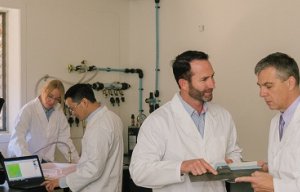
USQ to develop next-generation aircraft repairs
Researchers at Penn State have developed a procedure for making fabrics that not only self-heal but can also protect people from toxic materials.

27th July 2016
Innovation in Textiles
|
University Park, PA
A team of researchers at the Penn State have developed a procedure for making fabrics for protective suits that not only self-heal but can also protect people from toxic materials.
The procedure consists of dipping the material in a series of liquids to create layers of material to form a self-healing, polyelectrolyte layer-by-layer coating.
According to the article describing the method in the ACS Applied Materials & Interfaces, this coating is deposited “under ambient conditions in safe solvents, such as water, at low cost using simple equipment amenable to scale-up.” Polyelectrolyte coatings are made up of positively and negatively charged polymers, in this case polymers like those in squid ring teeth proteins.
“Fashion designers use natural fibres made of proteins like wool or silk that are expensive and they are not self-healing," said Melik C. Demirel, professor of Engineering Science and Mechanics at Penn State. "We were looking for a way to make fabrics self-healing using conventional textiles. So we came up with this coating technology.”
“We currently dip the whole garment to create the advanced material,” said Demirel, who is also a member of the Huck Institutes of the Life Sciences. “But we could do the threads first, before manufacturing if we wanted to.”
During the layering, enzymes can be incorporated into the coating. The researchers used urease – the enzyme that breaks urea into ammonia and carbon dioxide – but in commercial use, the coating would be tailored with enzymes matched to the chemical being targeted.
“If you need to use enzymes for biological or chemical effects, you can have an encapsulated enzyme with self-healing properties degrade the toxin before it reaches the skin,” explained Demirel.
Many toxic substances can be absorbed through the skin. Organophosphates, for example, which are used as herbicides and insecticides are absorbed through the skin and can be lethal. Some of these chemicals have also been used as nerve agents.
A garment coated with a self-healing film containing an organophosphate hydrolase, an enzyme that breaks down the toxic material, could limit the exposure, researchers report. The squid ring teeth polymer is self-healing in the presence of water, so laundering would repair micro and macro defects in the coating, making the garments rewearable and reusable. “The coatings are thin, less than a micron, so they wouldn't be noticed in everyday wear,” said Demirel. “Even thin, they increase the overall strength of the material.”
For manufacturing environments where hazardous chemicals are necessary, clothing coated with the proper enzyme combination could protect against accidental chemical releases, according to the conducted study. The future use of these coatings in medical meshes could also help patients minimize infections for quick recovery.
Also working on this project from Penn State were Srinivas Tadigadapa, professor of electrical engineering and affiliate of the Materials Research Institute; David Gaddes, graduate student in bioengineering; and Huihun Jung and Abdon Pena-Francesch, graduate students in engineering science and mechanics.
Outside the university, Genevieve Dion, assistant professor and director, Shima Seiki Haute Technology Lab, Drexel University; and Walter J. Dressick, U.S. Naval Research Laboratory, Washington, D.C. also worked on the project.

Business intelligence for the fibre, textiles and apparel industries: technologies, innovations, markets, investments, trade policy, sourcing, strategy...
Find out more